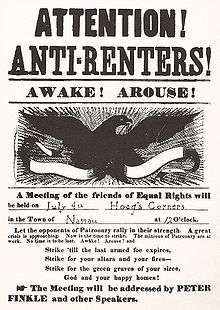Anti-Rent War

The Anti-Rent War (also known as the Helderberg War) was a tenants' revolt in upstate New York during the early 19th century.
Events
The incident began with the death of Stephen Van Rensselaer III in 1839. Van Rensselaer, who was described as having "...proved a lenient and benevolent landowner" was the patroon of the region at the time, and was a descendant of Kiliaen Van Rensselaer, the first patroon of the Manor of Rensselaerswyck. The patroons owned all the land on which the tenants in the Hudson Valley lived, and used feudal leases to maintain control of the region. When he died, his will directed his heirs to collect outstanding rents to apply to the estate debts. When his heirs attempted to collect the rents which Van Rensselaer had long deferred, tenant farmers resisted. The tenants could not pay the amounts demanded, could not secure favorable terms, and could not obtain relief in the courts, so they revolted.
The first mass meeting of tenant farmers leading to the Anti-Rent War was held in Berne, New York on July 4, 1839. In January 1845, one hundred and fifty delegates from eleven counties assembled in St. Paul's Lutheran Church,[1] Berne to call for political action to redress their grievances.[2]
Results
The Anti-Rent War led to the creation of the Antirenter Party, which had a strong influence on New York State politics from 1846–51.
Trials of leaders of the revolt, charged with riot, conspiracy and robbery, were held in 1845. Participants as counsel in the trials included Ambrose L. Jordan, as leading counsel for the defense, and John Van Buren, the state attorney general, who personally conducted the prosecution. At the first trial, the jury came to no conclusion.
During a re-trial in September 1845, the two leading counsels started a fist-fight in open court. Both were sentenced by the presiding judge, Justice John W. Edmonds, to "solitary confinement in the county jail for 24 hours." At the conclusion of the trial, one defendant, Smith A. Boughton, was sentenced to life imprisonment. After the election of John Young as governor, who had the support of the Anti-Renters, he pardoned Boughton.
People involved
- Lawrence Van Deusen, president of the Anti-Rent Association of Albany County, New York.[3]
See also
- Anya Seton's novel Dragonwyck (1944) is set during the Anti-Rent War.[4]
- List of incidents of civil unrest in the United States
- Anti-rent movement and downfall, for further information on how the following years convinced landed proprietors to sell out their interests
References
- ↑ Berne, NY: history, archived from the original on November 5, 2011, retrieved April 15, 2016
- ↑ Christman, Henry. Tin Horns and Calico, a Decisive Episode in the Emergence of Democracy. ISBN 0-685-61130-2.
- ↑ Charles W. McCurdy (2001). Anti-Rent Era in New York Law and Politics, 1839-1865. p. 205.
It was a bittersweet occasion for Lawrence Van Deusen, president of the Anti-Rent Association of Albany County. Van Deusen took pride in the unity and staying power of his fellow tenants since 1839, when Stephen Van Rensselaer IV ...
- ↑ Seton, Anya (1944), Dragonwyck (novel)
Further reading
- Christiansen, Candace (1992), Calico and Tin Horns, ISBN 0-8037-1179-4.
- Ford, Eric (June 2002), "New York's Anti-rent War 1845–1846", Contemporary Review.
- Kubik, Dorothy (1997), A Free Soil — A Free People: The Anti-Rent War in Delaware County, New York, ISBN 0-935796-86-X.
- McCurdy, Charles W (2001), The Anti-Rent Era in New York Law and Politics, 1839–1865, ISBN 0-8078-2590-5.
- Reeve, Huston (2004), "Popular Movements and Party Rule: The New York Anti-Rent Wars and the Jacksonian Political Order", in Pasley, Jeffrey L; Robertson, Andrew W; Waldstreicher, David, Beyond the founders: new approaches to the political history of the early American republic, Chapel Hill: University of North Carolina Press, pp. 355–86.